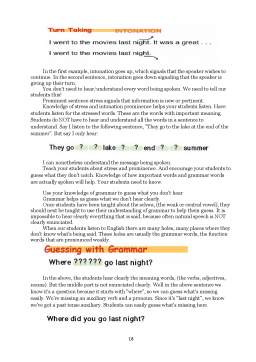Cuprins
- 1. Introduction
- 2. Goals and Techniques for Teaching Listening
- 2.1 Teaching Listening Better: Is Listening being taught as well as it could be?
- 2.2 What do we teach when we teach Listening?
- 2.3 The Listening Skills (an all too often forgotten skill set)
- 2.4 The Default Method The Listening Process
- 2.5 Integrating Meta cognitive Strategies
- 2.6 Using Authentic Materials and Situations
- 3. Strategies for Developing Listening Skills
- 3.1 Listening Strategies
- 3.2 Listening for Meaning
- 4. Developing Listening Activities
- 4.1 construct the listening activity around a contextualized task.
- 4.2 Define the activity's instructional goal and type of response
- 4.3 Check the level of difficulty of the listening text
- 4.4 Using the pre-listening activities
- 4.5 Matching while-listening activities to the instructional goal, the listening purpose, and students' proficiency level.
- 5. Using Textbook Listening Activities
- 5.1 Integrating Listening Strategies with Textbook Audio and Video
- 6. Assessing Listening Proficiency
- 7. Conclusion
- 8. Sources:
Extras din curs
Introduction
Listening is the language modality that is used most frequently. It has been estimated that adults spend almost half their communication time listening, and students may receive as much as 90% of their in-school information through listening to instructors and to one another. Often, however, language learners do not recognize the level of effort that goes into developing listening ability.
Far from passively receiving and recording aural input, listeners actively involve themselves in the interpretation of what they hear, bringing their own background knowledge and linguistic knowledge to bear on the information contained in the aural text. Not all listening is the same; casual greetings, for example, require a different sort of listening capability than do academic lectures. Language learning requires intentional listening that employs strategies for identifying sounds and making meaning from them.
Listening involves a sender (a person, radio, television), a message, and a receiver (the listener). Listeners often must process messages as they come, even if they are still processing what they have just heard, without backtracking or looking ahead. In addition, listeners must cope with the sender's choice of vocabulary, structure, and rate of delivery. The complexity of the listening process is magnified in second language contexts, where the receiver also has incomplete control of the language.
Given the importance of listening in language learning and teaching, it is essential for language teachers to help their students become effective listeners. In the communicative approach to language teaching, this means modeling listening strategies and providing listening practice in authentic situations: those that learners are likely to encounter when they use the language outside the classroom.
Goals and Techniques for Teaching Listening
Instructors want to produce students who, even if they do not have complete control of the grammar or an extensive lexicon, can fend for themselves in communication situations. In the case of listening, this means producing students who can use listening strategies to maximize their comprehension of aural input, identify relevant and non-relevant information, and tolerate less than word-by-word comprehension.
Teaching Listening Better: Is Listening being taught as well as it could be?
In Listening classes, students are usually given practice in listening but they are not actually taught listening. Practice is not enough.
Research and case studies have told us many things about how listening should be taught. But often, this knowledge has not made the jump into classroom practice. While many classes are based on the idea of giving students lots of practice with English, research tells us that we also need to teach listening.
In addition to giving students plenty of listening practice. We should also break the skill of listening into micro-skill components and make sure that our students are aware of what they need to know to understand how to listen to English.
Students need to know and understand:
• how words link together (liaison)
• how vowels weaken (the central vowel)
• how sounds mix together (assimilation)
• how sounds disappear (elision)
• how syllables disappear (ellipsis)
• how helping sounds are used between vowel sounds (intrusion)
• how intonation helps with conversational turn taking (intonation)
• how stress signals new information (prominence)
• how to use grammar to help guess meaning (strategies)
• how to use discourse knowledge to help guess meaning (strategies)
• how to use knowledge of intonation and stress to guess meaning (strategies)
We should know these features.
Everyone knows that many Kyrgyz learners say that 'listening' is their weak point with English. There is a very simple reason for this. Most Kyrgyz students have never been taught how to listen to English. They have had practice but they have never actually been taught or given guidance about how to listen to English.
What do we teach when we teach Listening?
When we teach listening we need to teach not only English, but we also need to teach how it is used. We need to teach both:
1. the language system, (our knowledge of language: grammar and vocabulary etc.) and
2. the use of the language system, (the skills of language use)
The problem with most listening classes is that they get stuck at number 1. Too many classes concentrate on teaching the language system and miss the skills of language, in this case listening.
Our knowledge of the language system includes our knowledge of words, how these words are properly put in order (syntax or grammar), how these words are said in connected streams (phonology), how these words are strung together in longer texts (discourse) and so on.
Preview document
Conținut arhivă zip
- Teaching Listening.doc




































